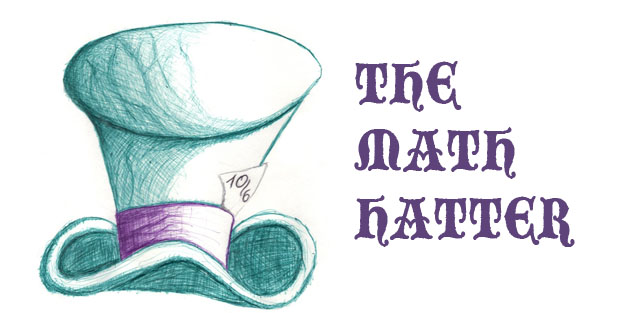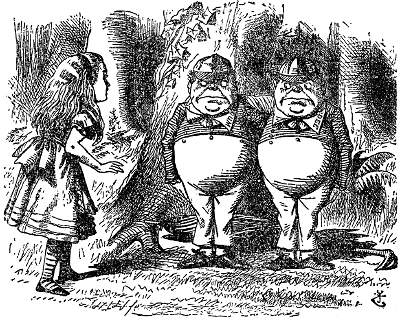Because she was too busy helping the king’s men and the king’s horses putting Humpty Dumpty together back on the wall, Alice didn’t have time to find a gift for Tweedledum and Tweedledee’s birthday. At the last minute, she gave each of them a $100 bill and the twins were happy. T-Dum said he would buy a brand new jacket while T-Dee felt he needed a new hat. But Alice disagreed, said it was better to save, so she opened a savings account for each one. In the end, the only thing the twins got to decide in the whole affair was the type of interest they would receive from the bank (1). T-Dee opted for simple interest, meaning he would receive 10% of his initial deposit at the end of each month, while T-Dum defiantly chose to get only 4% each month. However, the 4% would apply to the total amount on his account and not only the initial deposit of $100. This is called compound interest, because one gets interest from former interest. Alice did not quite understand the difference at the time and was not sure the twins did either.
Tweedledum and Tweedledee with Alice.
How does that work out ? Well, at the end of the first month, T-Dum receives 4% of $100 which is $4. He now has $104. T-Dee receives of course $10 (10% of $100) and already has $110, a net difference of $6 with his brother. After two months, T-Dee will again receive $10 and his balance will be $120. On the other hand, T-Dum gets 4% of $104 (the total amount after the first month), that is $4.16. He got an extra 16 cents from the interest of the first month. His grand total is then $108.16, still $11.84 less than T-Dee.
Raising a price twice by a rate of 10% is not the same as raising it once by 20%
When the first year is over, T-Dee has a balance of $220 while T-Dum (you can check that yourself) has only a bit more than $160. T-Dee still has an edge and to see how things go after that, we need to find an easy way to calculate both sums. For T-Dee it is quite simple as he gets a fixed amount of $10 each month. After n months he will have 100+10×n, a number I shall name Sn. If n=12 (1 year), we get S12=100+12×10=220, which is what we found earlier. Mathematicians call this an arithmetical sequence : to go from one term to the next one we just add(2) a fixed number, a constant. All arithmetical sequences share the following result: if you take three consecutive terms, the middle one is the average(3) of the other two.
It’s more complicated for T-Dum. To explain it better I shall speak a bit about percentages. First, you should know that raising a price twice by a rate of 10% is not the same as raising it once by 20%. If you start with $100, you get $121 in the first case and $120 in the second. The reason is that the second raise is applied to the already raised price of $110 and thus brings $11 more (4). The second thing you need to understand is that percentages are nothing else than fractions. If a price is raised by 20%, it means that the new price is composed of the old price plus 20% of the old price. That makes a total of 120% or 120/100, and that means that to go from the old price to the new one, you just need to multiply by 120/100 or 1.2. On the other hand, if the price is reduced by 20%, the new price will be 80% (or 80/100) of the old price, and can be obtained by multiplying the old price by 0.8.
“One never has too many hats”
Back to compound interests. For T-Dum, the rate of 4% means that each month his balance Tn is multiplyed by 1.04. Again, with n the number of months, that gives us the formula Tn=100×1.04^n. With n=12 we get T12=100×1.04^12 » 160.10322, which confirms the result obtained earlier. This new sequence is called a geometrical sequence : to go from one term to the next we just multiply by a constant. Geometrical sequences help explain the concept of geometrical average : if you take three consecutive terms of a geometrical sequence, the middle one is the geometrical average(5) of the other two.
So, now that we have our two formulas, Sn=100+10×n (for T-Dee) and Tn=100×1.04^n (for T-Dum), we can speed up the process, assuming that Alice doesn’t give them more money every year. I know she won’t next year, because she told me she would offer them both a new hat. As she said: « One never has too many hats, especially with quarrelsome twins. » Here goes :
Two years: S24=100+10×24=340 and T24=100×1.04^24 » 256.33
Three years: S36=100+10×36=460 and T36=100×1.04^36 » 410.39
Four years: S48=100+10×48=580 and T48=100×1.04^48 » 657.05
Five years: S60=100+10×60=700 and T60=100×1.04^60 » 1051.96
Ten years: S120=100+10×120=1300 and T120=100×1.04^120 » 11066.25
The verdict is clear. Tweedledum will overcome his slow start during the fourth(6) year after Alice’s gift and after a decade he will have more than 8 times more money. You might ask yourself : when will his $100 turn into a million dollar ? The answer is: in less than 20 years because T235=100×1.04^235 > 1 006 548.
The superiority of compound interests
Another interesting aspect of compound interests is that no matter how much you start with, it will take you the same time to double your balance. To go from $100 to $200 or from $10,000 to $20,000 it will take you less than 18 months at a rate of 4% and less than a year at the rate of 7%. The same thing is obviously not true with simple interests. Tweedledee needed only 10 months to go from $100 to $200 but it would take him more than 83 years to transform $10,000 into $20,000.
All right. Now that I have illustrated the superiority of compound interests, something you may know as exponential growth, let’s try to push the idea to its limits.
Imagine this situation. A bank invites Alice to put any amount of money on an account (all at once) and, after a decade has passed, they double the amount. That’s an interest rate of 100% over 10 years. That’s nice but after the twins’ story, Alice knows she’d be better off getting a lower rate more often, like twice 50% during the decade. In that case, the amount of money will be multiplied by 1.5(7) after 5 years and by 1.5 again at the end of the decade. But 1.5×1.5=2.25 so that means she would have 2.25 times the initial amount instead of just 2. I other words $1,000 would become $2,250 instead of just $2,000.
“Compound effect”
What if Alice gets a yearly rate of 10% ? Then her bank balance would be multiplied 10 times by 1.1 and since 1.1^10=2.59 that means her initial balance would be almost 2.6 times bigger.
With a monthly rate for 120 months (I’ll save you the calculation) the number we get is about 2.7. But we can go on. If interest is paid every day for ten years surely the « compound effect » will be noticeable. Well, surprisingly, the new value is just a little less than 2.718, a very small improvement from the previous result(8). Let’s finish this. Every hour : 2.718267. Every minute : 2.718299. Every second : 2.71828187.
You get the point. There seems to be a limit to the compound magic. Even if interest was paid an infinitely large number of times(9) (at an infinitely small rate), Alice’s $1,000 would never go over $3,000. She would be stuck with only $2718.28. This result may seem odd for at least two reasons. First you may be surprised by the fact that there is a limit, and then you may wonder about the limit itself : 2.7182818284 to the 10th decimal. Where does this come from?
The limits of compound interests
Well, that number is actually quite famous and important. It appeared in the first quarter of the 17th century as the base of the natural logarithm and, of course, logarithms are connected to exponential functions which explain the exponential growth we encountered before. But if you’re not very well acquainted with analysis and calculus this may not speak to you that much. The story of the invention of logarithms would indeed require another article.
Mathematicians call this number Euler’s constant (and name it e) after the Swiss mathematician who computed its value to the 23rd decimal and published the result in his Introductio in analysin infinitorum (1748).
A mathematical congress and a few hats…
As you may have already noticed, the number goes 2.71828 1828 and it means that there is a very simple way to memorize its value (beyond 2.7) especially if the year 1828 has any particular meaning to you.(10) Just don’t be fooled in thinking the pattern repeats because there is actually nothing rationnal about e.
An alternative is the infinite sum : e = 1 + 1/1 + 1/2 + 1/6 + 1/24 + 1/120 + 1/720 +… where the denominators of the succeeding fractions follow this simple rule :
2=1×2 6=1×2×3 24=1×2×3×4 120=1×2×3×4×5 720=1×2×3×4×5×6
The number 1×2×3×4×…×N is quite useful in mathematics. It is called the factorial of N and written N !(11) If you compute the formula up to 6 ! you already get 2.718, a fairly good approximation.
Another interesting aspect of the number e is that it has a tendency to show up in domains of mathematics where it is not expected. I shall give you just one example here and, of course, none is more suited than the famous « hat problem ». Imagine a mathematical congress at the beginning of the 20th century. Every day, each participant checks his hat in the morning (with the exception of Emmy Noether of course ) and recuperates it at the end of the meetings. One night, there is a massive electricity shutdown and everyone picks up his hat at random, unable to see if it belongs to him or not. The question is : what is the probability that not one of the mathematicians gets his own hat ? Well of course the answer depends on the number of participants but, suprisingly enough, as that number gets larger, the probability approaches 1/e… (12)
(1) Which Alice refered to as « T-D bank ».
(2) Or substract, which is the same since the invention of negative numbers.
(3) The most common average is actually called « the arithmetical average ».
(4) The same reasoning would show that a rebate of 10% after a raise of 10% won’t bring the price back to the original one.
(5) Mathematicians also use the and the .
(6) At the end of the 43rd month to be exact.
(7) Remember : 100%+50%=150%=150/100=1.5
(8) Even if you count 2 or 3 extra days due to leap years.
(9) This is actually the limit of the sequence (1+1/n)n.
(10) First publication of Webster’s An American Dictionary of the English Language, for example.
(11) We already encountered factorials in a previous story but a little reminder doesn’t hurt.
(12) I would put an exclamation point here but you might think it’s a factorial.
About the Author :
Originally from Brittany, David Soquet graduated from the Université de Rennes, before becoming a math teacher. After honing his skills at a middle school near Paris, he joined the Lycée Français in 2008. He is the father of two children and is passionate about the history of science. In his teaching, he tries to balance the rigor required by mathematics with humor and discovery. He is very curious and his interests range from modular origami and norse mythology to Fritz Lang’s cinema and music.



